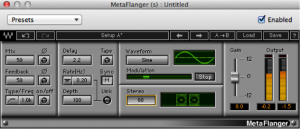Flange is the effect of combing out frequencies in a continuously changing frequency range. The flange effect is created by adding two identical audio signals, with one slightly delayed relative to the other, usually on the order of milliseconds. The effect involves continuous changes in the amount of delay, causing the combed frequencies to sweep back and forth through the audible spectrum.
In the days of analog equipment like tape decks, flange was created mechanically in the following manner: Two identical copies of an audio signal (usually music) were played, simultaneously and initially in sync, on two separate tape decks. A finger was pressed slightly against the edge (called the flange) of one of the tapes, slowing down its rpms. This delay in one of the copies of the identical waveforms being summed resulted in the combing out of a corresponding fundamental frequency and its harmonics. If the pressure increased continuously, the combed frequencies swept continuously through some range. When the finger was removed, the slowed tape would still be playing behind the other. However, pressing a finger against the other tape could sweep backward through the same range of combed frequencies and finally put the two tapes in sync again.
Artificial flange can be created through mathematical manipulation of the digital audio signal. However, to get a classic sounding flanger, you need to do more than simply delay a copy of the audio. This is because tape decks used in analog flanging had inherent variability that caused additional phase shifts and frequency combing, and thus they created a more complex sound. This fact hasn’t stopped clever software developers, however. The flange processor shown in Figure 7.9 from Waves is one that includes a tape emulation mode and includes presets that emulate several kinds of vintage tape decks and other analog equipment.
